Who's Who In Space Exploration
.open_headline {
font-family: palatino linotype, serif;
font-size: 24px;
color: #333;
}
.open_nav {
font-family: arial, sans;
font-size: 13px;
color: #aabfff;
font-weight: bold;
text-decoration: none;
}
Pioneers in Space

Yuri A. Gagarin
Gagarin was born in 1934 on a collective farm in central Russia, about 100 miles west of Moscow. He attended a technical school near a large airplane factory where he witnessed test flights and interacted with pilots. After finishing technical school with honors, he entered the Soviet Air Force Academy and graduated with honors in 1957. He became a military fighter pilot and was selected to be part of the first cosmonaut training program in 1959. On April 12, 1961, Gagarin became the first human in space and the first human to orbit Earth. The cosmonaut's space flight in Vostok 1lasted one hour and 48 minutes before he parachuted to earth. Gagarin died on March 27, 1968, in a plane crash while he was training for his next space flight.
Sources: NASA, Current Biography 1961. Photo: AP.
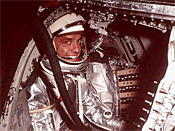
Alan Shepard
Shepard was born in New Hampshire in 1923. After graduating from the United States Naval Academy in Annapolis, Md., Shepard served on a destroyer during World War II. He was a Navy test pilot at the time he was selected to join the astronaut corps. On May 5, 1961, Shepard became the first American to enter space, making a 15-minute flight aboard the spacecraft he named Freedom 7, which was powered by a Redstone booster. Unfortunately, Shepard was grounded from 1963 to 1969 due to an inner ear ailment. However, after treatment, he was able to return to the corps of active astronauts and became the fifth man to walk on the moon in 1971. While on the moon, Shepard played golf with a club he had carried onboard the lunar spacecraft of Apollo 14. Following his moon adventure, he became an admiral in the U.S. Navy, the first astronaut to ever achieve such a rank. In 1974, Shepard retired from the astronaut corps and the Navy. Alan Bartlett Shepard, Jr. died in California on July 22, 1998.
Sources: NASA, Congressional Committee on Science, Space, and Technology. Photo: AP.
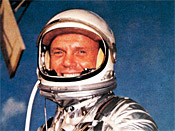
John Hershel Glenn Jr.
Glenn was born in Cambridge, Ohio on July 18, 1921. He graduated from Muskingum College with a degree in engineering. After the United States entered World War II, Glenn joined the naval aviation cadet program. Upon graduation, he was commissioned in the Marine Corps. He flew numerous combat missions during World War II and during the Korean conflict. After service in Korea, Glenn attended the naval test pilot school. He served as project officer on a number of aircraft after his graduation. While serving as a project officer, he set a transcontinental speed record by flying from Los Angeles to New York in 3 hours and 23 minutes. It was the first transcontinental flight to average supersonic speeds. Glenn was selected as one of seven Project Mercury astronauts in 1959. In February of 1962, he became the first American to orbit Earth. Two years later, he resigned from the Manned Spacecraft Center. Glenn retired from the Marine Corps in 1965. He was a business executive from 1965 until his election to the U.S. Senate in November of 1974. On Jan. 16, 1998, NASA announced the senator's selection as a member of the crew of space shuttle Discovery mission STS-95. In addition to performing duties as a payload specialist, Glenn would be a subject for research on how weightlessness affects the body of an older person. Discovery was launched on Oct. 29, 1998. This mission was accomplished in 134 Earth orbits, traveling 3.6 million miles in 213 hours and 44 minutes.
Sources: NASA, Congressional Committee on Science, Space, and Technology. Photo: AP.

Valentina Tershkova
Soviet cosmonaut Valentina Tereshkova was born in the Yaroslavl region of Russia in 1937. Her parents were laborers and at the age of 16, she left school and began working. She continued her education by correspondence courses. Tereshkova became interested in parachute jumping at an early age and it was her expertise in parachute jumping that led to her selection as a cosmonaut. Tereshkova was a textile-factory assembly worker and an amateur parachutist when she was recruited into the cosmonaut program. Under the direction of Soviet premier Nikita Khrushchev, four women were selected to be trained for a special woman-in-space program. Of the four women selected, only Tereshkova completed a space mission. Tereshkova was launched aboard Vostok 6 on June 16, 1963, and became the first woman to fly in space. During the 70.8-hour flight, Vostok 6 made 48 orbits of Earth. Upon completion of her mission, Tereshkova was honored with the title Hero of the Soviet Union. She never flew again, but she did become a spokesperson for the Soviet Union. While fulfilling this role, she received the United Nations Gold Medal of Peace. On Nov. 3, 1963, Tereshkova married astronaut Andrian Nikolayev. Their first child, a daughter named Elena, was a subject of medical interest because she was the first child born to parents who had both been exposed to space. Elena later went on to become a medical doctor.
Sources: NASA, Congressional Committee on Science, Space, and Technology. Photo: AP.

Alexei Leonov
Born in Siberia, Russia in 1934, Leonov graduated from the Chuguyev Air force School and Zhukovskiy Air Force Engineering Academy. He became an air force lieutenant colonel, fighter pilot and parachutist. He was chosen for the cosmonaut program in 1960 and was the first human to walk in space on the Voskhod 2 mission. He resigned from the Soviet corps of cosmonauts in 1975.
Sources: Congressional Committee on Science, Space, and Technology, Contemporary World Issues: Space Exploration. Photo: NASA.

Edward White
Born in San Antonio, Texas in 1930, White graduated from the West Point Military Academy and later earned a Masters in aeronautical engineering. He joined the Air Force and served in a fighter squadron in Germany. He was chosen as part of the second group of astronauts in 1962. White piloted Gemini 4 and was the first American to walk in space and use a hand-held maneuvering unit to propel himself in space. He was selected to pilot the command module for the Apollo 1 mission, but in NASA's first disaster in the space exploration program, White and fellow crew members Virgil Grissom and Roger Chaffee all perished in a fire during training on Jan. 27, 1967.
Sources: Congressional Committee on Science, Space, and Technology, Contemporary World Issues: Space Exploration. Photo: AP.
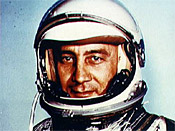
Virgil "Gus" Grissom
Born in 1926 in Mitchell, Ind., Grissom earned a Bachelors of Science degree in mechanical engineering and became an Air Force lieutenant colonel. He flew combat missions in the Korean conflict and went on to become a test pilot. NASA chose Grissom as part of the first group of astronauts. In 1961, he piloted the Mercury flight Liberty Bell-7 into a sub-orbital flight around Earth and later commanded Gemini 3 into full orbit. Grissom was to command Apollo 1 on NASA's first mission to the moon, but a training exercise ended in the space program's first tragedy. Grissom and fellow crew members Edward White and Roger Chaffee all perished in a fire during training on Jan. 27, 1967.
Sources: Congressional Committee on Science, Space, and Technology, Contemporary World Issues: Space Exploration. Photo: AP.
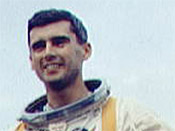
Roger Chaffee
Born in Grand Rapids, Mich., in 1935, Chaffee earned a Bachelors of Science in aeronautical engineering and became a navy pilot. After applying to NASA's space program twice, he was chosen in the third group of astronauts and was to fly as communications officer on the Apollo 1 mission. Chaffee and fellow crew members Edward White and Virgil Grissom all perished in a fire during training on Jan. 27, 1967.
Sources: Congressional Committee on Science, Space, and Technology, Contemporary World Issues: Space Exploration. Photo: AP.

Vladimir Komarov
Soviet cosmonaut Vladimir Komarov was among the first group of pilots chosen to fly into space for the U.S.S.R. Although the discovery of a minor heart murmur temporarily delayed his ascent into Earth orbit aboard a rocket, he did command the first-ever three-man mission into orbit, flying Voskhod 1 in 1964. Three years later, the air force colonel flew into space again, alone this time, aboard a new capsule - Soyuz 1. But during his descent back to Earth on April 24, 1967, the spacecraft's parachute lines became tangled and it crashed to the ground, killing Komarov. He would become the first person to die in a spaceflight and the Soviet Union's first cosmonaut casualty. Komarov joined flight training at age 15 during the middle of World War II and became a pilot in 1949. He went on to graduate from four different air force colleges before joining the Soviet space program.
Sources: Congressional Committee on Science, Space, and Technology, Contemporary World Issues: Space Exploration. Photo: AP.

William A. Anders
Born in 1933 in Hong Kong to a military family, Anders attended the Naval Academy at Annapolis and became an Air Force major. He was also a fighter pilot in the Air defense Command. He holds a Master's degree in nuclear engineering and served as a technical manager at the Air Force Weapons Laboratory in New Mexico. He was recruited by NASA in 1963 when emphasis was placed on scientific training in their qualifications. Anders became systems engineer on the Apollo 8 mission, which was the first manned flight to the moon. Anders was set to pilot and land a lunar module that was supposed to be part of the Apollo 8 mission, but due to development problems, that part of the mission was put on hold. Anders, Frank Borman, and James Lovell orbited the moon 10 times on Dec. 25, 1968. After Apollo 8, Anders resigned from the space program.
Sources: Congressional Committee on Science, Space, and Technology, Current Biography 1961. Photo: NASA.

Frank Borman
Born in 1928 in Gary, Indiana, Borman graduated from West Point Military Academy and became and Air Force colonel. Borman earned his Master's degree in aeronautical engineering. He served in the 44th Fighter Bomber Squadron in the Phillipines from 1951 to 1956 and later taught at the Air Force Fighter Weapons School. He also spent some time as an instructor at the Air Force Aerospace Research Pilots School and West Point. Borman was chosen by NASA in 1962 as part of the second group of astronauts. He served as the command pilot for the Gemini 7 mission, which made the first rendezvous in space with Gemini 6. His next mission was as commander of the historic Apollo 8 mission that orbited the moon 10 times. Borman resigned from the space program in 1970.
Sources: Congressional Committee on Science, Space, and Technology, Contemporary World Issues: Space Exploration. Photo: NASA.

James Lovell
Born in Cleveland, Ohio in 1928, Lovell graduated from the U.S. Naval Academy and became a test pilot and a Navy captain. NASA recruited him in 1962 and Lovell flew into orbit aboard Gemini 7, which made a space rendezvous with Gemini 6. He also flew on NASA's first manned mission to the moon aboard Apollo 8, which orbited the moon 10 times. Lovell's last flight was as commander of the near-catastrophic Apollo 13, which suffered an oxygen explosion at 205,000 miles above Earth. The resourcefulness of Lovell and his crew along with help from mission control saved their lives. After Apollo 13, Lovell resigned from the space program.
Sources: Congressional Committee on Science, Space, and Technology, Contemporary World Issues: Space Exploration. Photo: NASA.

Neil Alden Armstrong
Armstrong was born in 1930 in Wapakoneta, Ohio. He holds a degree in aeronautical engineering from Purdue University and a Masters degree in aerospace engineering from the University of Southern California. From 1949 to 1952, Armstrong was a naval aviator. Upon leaving military service, he became a test pilot. While serving as a test pilot, he was chosen to be a member of the astronaut corps. Though he was on the backup crew of many previous flights, his first space flight occurred in 1966 aboard Gemini 8. During this flight, he and fellow astronaut David Scott successfully performed the first docking in space between two vehicles. In July of 1969, Armstrong was the commander of Apollo 11, America's first attempt to land a manned vehicle on the moon. On July 20, 1969, Armstrong and fellow astronaut Edwin Aldrin successfully touched down on the lunar surface. As Armstrong became the first person to touch the moon's surface, he spoke the unforgettable phrase, "That's one small step for man; one giant leap for mankind." He and Aldrin explored the moon's surface for 2.5 hours. Armstrong was awarded the Presidential Medal of Freedom in recognition of his accomplishments and his contributions to the space program.
Sources: NASA, Congressional Committee on Science, Space, and Technology, Current Biography 1961. Photo: AP.
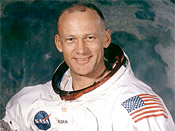
Edwin "Buzz" Aldrin
Edwin Eugene Aldrin Jr., better known as Buzz Aldrin, was born in 1930. He graduated from the U.S. Military Academy at West Point, N.Y. and became an air force pilot and colonel. He flew 66 combat missions in the Korea conflict and later served in West Germany. He earned his Ph.D. from the Massachusetts Institute of Technology, Cambridge in orbital mechanics. Later that year NASA recruited him to be an astronaut. On Nov. 11, 1966, he joined James Lovell on the four-day Gemini 12 flight. Aldrin's five-and-a-half-hour walk in space proved that man is able to function effectively in space, and he set the record for the longest space walk ever. Apollo 11 was his next mission. Aldrin piloted the lunar landing module on this moon mission with Neil Armstrong, and Michael Collins, that launched on July 16, 1969. Four days later, Armstrong and Aldrin landed near the edge of Mare Tranquillitatis on the lunar surface. Aldrin became the second man to step foot on the moon. Aldrin retired from NASA in 1971 to head the Aerospace Research Pilots' School at Edwards Air Force Base, Calif.. In March 1972 he retired from the Air Force to enter private business.
Sources: NASA, Congressional Committee on Science, Space, and Technology, Contemporary World Issues: Space Exploration. Photo: AP.
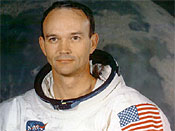
Michael Colllins
Born in 1930, Collins graduated from West Point Military Academy and went on to become a test pilot in the Air Force. He was chosen for NASA's third group of astronauts in 1963 and piloted the Gemini 10 mission three years later. He went to the moon as the command module pilot on the historic Apollo 11 mission and stayed in orbit around the moon while his crewmates explored the lunar surface. He resigned from NASA and Air Force active duty in 1970.
Sources: Congressional Committee on Science, Space, and Technology, Contemporary World Issues: Space Exploration. Photo: AP.

Vladimir Remek
Czechoslovakian Vladimir Remek became the first non-America, non-Russian to travel into space when he joined two cosmonauts on the Soyuz 28/Salyut 6 mission in 1978. The colonel, born on Sept. 26, 1948, served as a fighter pilot for the Czechoslovak Air Force from 1970 until he was chosen as a Czech cosmonaut candidate in 1976. He graduated from Kosice Air Force College in 1970 and from the Soviet Union's Gagarin Air Force Academy in 1976.
Sources: Congressional Committee on Science, Space, and Technology, Contemporary World Issues: Space Exploration. Photo: spacefacts.de
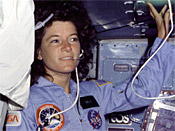
Sally Ride
Ride was born in Los Angeles in 1951. As a young girl, she wanted to become a professional tennis player and, at one time, was a ranked player on the junior tennis circuit. She attended Stanford University where she earned a Bachelor of Arts degree in English and a Bachelor of Science degree, Masters degree and a Ph.D. all in Physics. She was accepted into the astronaut corps in 1978 and completed her training as a mission specialist in 1979. On June 18, 1983 she became the first American woman to orbit Earth when she flew aboard space shuttle Challenger. Her second flight was also aboard Challenger in 1984. Ride was a member of the team chosen to investigate the explosion of Challenger in 1986. She left the astronaut corps in 1987 to join the faculty of Stanford University, her alma mater. Since 1989, Ride has been on the faculty of the University of California at San Diego, where she also heads the California Space Institute.
Sources: NASA, Congressional Committee on Science, Space, and Technology. Photo: NASA.

Christa McCauliffe
Sharon Christa C. McAuliffe was a 37-year-old high school social studies teacher when she died during the Jan. 28, 1986, explosion of space shuttle Challenger. The Framingham, Mass., resident was to become the first private American citizen selected in a national competition to fly on the space shuttle. She was chosen from more than 11,000 teachers who applied in NASA's first citizen-in-space competition. In preparation for the flight, she underwent 120 hours of training at the Johnson Space Center near Houston and was to teach a class from space. Born on Sept. 2, 1948, McAuliffe earned her Bachelor's degree from Framingham State College and a Master's from Bowie State College in Bowie, Md. She and her husband, Steven, had two children: Scott and Caroline.
Sources: NASA, Congressional Committee on Science, Space, and Technology, Contemporary World Issues: Space Exploration. Photo: NASA.

Yang Liwei
Lt. Col. Yang Liwei, 38, a pilot for the People's Liberation Army air force since 1983, clambered into Shenzhou 5 with a tentative smile and a wave as technicians gently pushed down on his helmet so he wouldn't hit his head.
The identity of China's first "taikonaut" (after "taikong," the Chinese word for space) was kept closely guarded until the launch took place. Still, state-controlled media expressed certainty in the hours before liftoff that it would be Yang.
But, the government said, he and 13 other finalists had begun drills in Shenzhou 5's actual capsule more than three weeks before the launch.
"When I boarded the spacecraft for the first time, I couldn't help feeling excited," Yang said, according to Xinhua. "I decided that I must fly it."
The 5-foot, 6-inch Yang, who comes from a family of teachers in Liaoning province in China's industrial northeast, joined the PLA at age 18 and graduated from the air force's No. 8 Aviation College. He entered the astronaut program in 1998. He is married to Zhang Yumei, who also serves in China's space program, and they have an 8-year-old son.
He has 1,350 hours of flight experience, the government says. Colleagues describe him as "miraculously dedicated," Xinhua said, suggesting the hagiography of Yang is already under way.
China typically selects ordinary people and holds them up as heroes and examples to the population of 1.3 billion, and Yang is an easy sell.
"I will not disappoint the motherland. I will complete each movement with total concentration. And I will gain honor for the People's Liberation Army and for the Chinese nation," the popular Web site Sina.com quoted Yang as saying.
Yang was picked over two other finalists for the flight, Zhai Zhigang and Nie Haisheng, also air force pilots. They had been selected from among the 14 finalists culled from an original pool of 1,500 in China's first astronaut corps. They stood behind him as their president addressed them before dawn.
Yang's $12 million space suit consists of 14 layers that took 15 minutes to don with the help of technicians, the general commander of the astronaut program, Su Shuangning, told Phoenix Television, a Hong Kong broadcaster with close ties to the mainland's military.
For his 14 orbits, he is spending about 20 hours in the craft, which is 29 feet tall and weighs 17,138 pounds.
Chinese astronauts are known as "yuhangyuan," or "travelers of the universe." "Taikonaut" is their English nickname.
Source: The Associated Press. Photo: AP.
